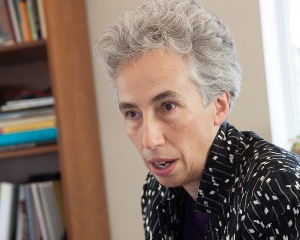Pension plan's solvency deficit a pressing financial issue: Caroline Davis
November 5, 2013
Share
With a large solvency deficit, Queen’s is facing the need to make significant additional payments into its pension plan. With the Ontario government recently proposing to defer those mandated payments, Craig Leroux, Senior Communications Officer, spoke with Caroline Davis, Vice-Principal (Finance and Administration), to find out what it means for the university.
Craig Leroux: First off, what is a solvency deficit and why is it a problem for Queen’s?

Caroline Davis: Simply put, a solvency deficit means that, if the pension plan were closed up today, it would not be able to pay all of the benefits it owes to the plan’s members. Under Ontario’s existing rules, Queen’s is required to make special payments to cover any solvency shortfall beginning in 2015.
As of its last valuation on August 31, 2012, the Queen’s Pension Plan (QPP) had a solvency deficit of $459 million. At that level, the university would have to make payments of roughly $35 million annually for a period of 10 years. These payments would need to be absorbed into departmental budgets and would mean a significant impact on the university’s operations – the 2013-14 Operating Budget is balanced, but there is no surplus available from budgeted revenues of just over $450 million to cover these additional payments. That’s why the solvency deficit is one of the most pressing financial issues facing Queen’s.
CL: How did Queen’s get into this situation?
CD: Like many other pension plans across Canada, the QPP was severely impacted by the global financial crisis of 2008. The solvency deficit is a product of that crisis. Negative investment returns in 2008 and 2009, combined with the very low interest rates that continue today, have put us into a situation where the plan’s liabilities – what it owes to current and future retirees – exceed the value of its assets – the amount of money in the plan.
CL: The Ontario government has proposed a change in its regulations that would defer solvency payments until 2018. Will that help?

CD: The government has proposed a three-year period during which public sector employers like Queen’s could decide to make interest-only payments on their solvency deficits. This would not eliminate our solvency problem and it would come at a cost. It’s a little like making only the minimum payments on your credit card.
In fact, the government’s proposal would not change the 10-year timeframe currently in place for us to pay down the solvency deficit; it simply squeezes those payments into the final seven years. That shorter time period would most likely mean larger payments down the road, and an even more severe impact on the operating budget.
CL: The Board of Trustees recently approved Queen’s 2012-13 financial statements, which show a surplus, mostly due to good investment returns in the pension plan. Do these returns help the solvency deficit situation?
CD: The financial statements reported a surplus of $67 million, but we need to be clear on where this surplus comes from. The majority is a result of gains in investments held by the university and the pension plan, and is not cash available for the university to spend. $58 million of the surplus remains within the QPP, and the strong performance of our investments this year helps to offset poor performance of prior years.
CL: So things have improved a bit?
CD: It is always positive when the QPP’s investments do well, also, interest rates have crept up a little. So we have asked the actuaries for a valuation as at August 31, 2013, and we expect to get the results in December. I’m expecting that the solvency deficit will have gone down a bit, and so will the solvency payments we’ll have to make, but the problem won’t have gone away altogether. And we mustn’t forget that investment returns can be volatile, and the good year we have just experienced is not a guarantee of future performance.
CL: What does the solvency deficit mean for the pensions of individual members?

CD: Remember that a solvency deficit means that there is not enough money in the plan to pay out all of its pension obligations if the plan were closed up. Queen’s is not about to shut its doors and there is no immediate danger of the plan winding up. Nevertheless, we do have an obligation to ensure that the plan is well funded, and that’s why the government requires employers like Queen’s to put additional money into the plan when there is a solvency deficit.
CL: What can Queen’s do about the pension solvency issue?
CD: The university does not have a pot of cash to pay an extra $35 million into the plan each year without taking money out of departmental budgets. And we face other significant financial pressures, such as reductions in the government’s per-student operating grants, tuition revenue increases capped at 3% annually, and roughly $243 million in deferred maintenance on campus.
All of this means that we operate in a very challenging environment with little room to manoeuvre. That’s why we are exploring several options to help us deal with the pension solvency issue, but there is no easy fix. We can’t overlook the strong possibility that significant cuts to operating budgets will have to be made in order to find the money to make solvency payments.
It’s not easy, but these challenges underscore the need for Queen’s to be very cautious financially as it continues to advance its research prominence and deliver an exceptional learning experience.